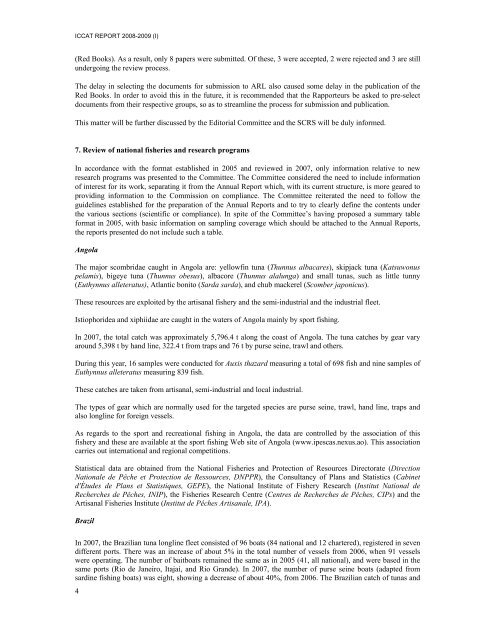REPORT OF THE STANDING COMMITTEE ON RESEARCH ... - Iccat
REPORT OF THE STANDING COMMITTEE ON RESEARCH ... - Iccat
REPORT OF THE STANDING COMMITTEE ON RESEARCH ... - Iccat
Create successful ePaper yourself
Turn your PDF publications into a flip-book with our unique Google optimized e-Paper software.
ICCAT <strong>REPORT</strong> 2008-2009 (I)(Red Books). As a result, only 8 papers were submitted. Of these, 3 were accepted, 2 were rejected and 3 are stillundergoing the review process.The delay in selecting the documents for submission to ARL also caused some delay in the publication of theRed Books. In order to avoid this in the future, it is recommended that the Rapporteurs be asked to pre-selectdocuments from their respective groups, so as to streamline the process for submission and publication.This matter will be further discussed by the Editorial Committee and the SCRS will be duly informed.7. Review of national fisheries and research programsIn accordance with the format established in 2005 and reviewed in 2007, only information relative to newresearch programs was presented to the Committee. The Committee considered the need to include informationof interest for its work, separating it from the Annual Report which, with its current structure, is more geared toproviding information to the Commission on compliance. The Committee reiterated the need to follow theguidelines established for the preparation of the Annual Reports and to try to clearly define the contents underthe various sections (scientific or compliance). In spite of the Committee’s having proposed a summary tableformat in 2005, with basic information on sampling coverage which should be attached to the Annual Reports,the reports presented do not include such a table.AngolaThe major scombridae caught in Angola are: yellowfin tuna (Thunnus albacares), skipjack tuna (Katsuwonuspelamis), bigeye tuna (Thunnus obesus), albacore (Thunnus alalunga) and small tunas, such as little tunny(Euthynnus alleteratus), Atlantic bonito (Sarda sarda), and chub mackerel (Scomber japonicus).These resources are exploited by the artisanal fishery and the semi-industrial and the industrial fleet.Istiophoridea and xiphiidae are caught in the waters of Angola mainly by sport fishing.In 2007, the total catch was approximately 5,796.4 t along the coast of Angola. The tuna catches by gear varyaround 5,398 t by hand line, 322.4 t from traps and 76 t by purse seine, trawl and others.During this year, 16 samples were conducted for Auxis thazard measuring a total of 698 fish and nine samples ofEuthynnus alleteratus measuring 839 fish.These catches are taken from artisanal, semi-industrial and local industrial.The types of gear which are normally used for the targeted species are purse seine, trawl, hand line, traps andalso longline for foreign vessels.As regards to the sport and recreational fishing in Angola, the data are controlled by the association of thisfishery and these are available at the sport fishing Web site of Angola (www.ipescas.nexus.ao). This associationcarries out international and regional competitions.Statistical data are obtained from the National Fisheries and Protection of Resources Directorate (DirectionNationale de Pêche et Protection de Ressources, DNPPR), the Consultancy of Plans and Statistics (Cabinetd'Études de Plans et Statistiques, GEPE), the National Institute of Fishery Research (Institut National deRecherches de Pêches, INIP), the Fisheries Research Centre (Centres de Recherches de Pêches, CIPs) and theArtisanal Fisheries Institute (Institut de Pêches Artisanale, IPA).BrazilIn 2007, the Brazilian tuna longline fleet consisted of 96 boats (84 national and 12 chartered), registered in sevendifferent ports. There was an increase of about 5% in the total number of vessels from 2006, when 91 vesselswere operating. The number of baitboats remained the same as in 2005 (41, all national), and were based in thesame ports (Rio de Janeiro, Itajaí, and Rio Grande). In 2007, the number of purse seine boats (adapted fromsardine fishing boats) was eight, showing a decrease of about 40%, from 2006. The Brazilian catch of tunas and4
















